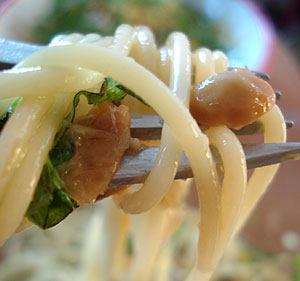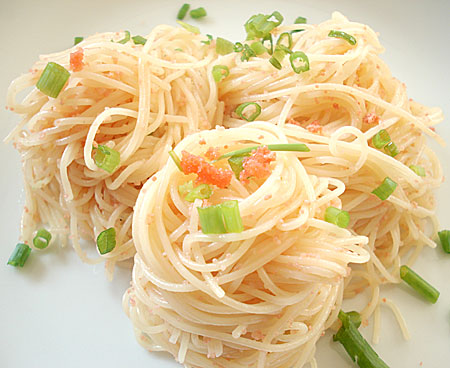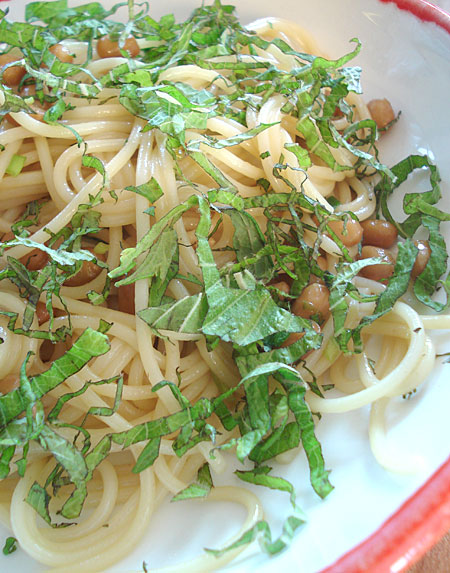Wafuu Pasuta (wafuu pasta): Japanese style pasta
 The word wafuu may sound like someone trying to say yahoo and not quite succeeding, but it actually means "Japanese-style" in Japanese.
The word wafuu may sound like someone trying to say yahoo and not quite succeeding, but it actually means "Japanese-style" in Japanese.
Italian style pasta has been popular in Japan since the post war period. In the beginning it was served with Italian, or at least Western European, style sauces, but some time in the '70s or so people started to experiment with Japanese flavors. Essentially, things that are usually eaten with white rice were mixed into or put on top of spaghetti and other pastas. These are known as wafuu pasuta or wafuu supagetti (say these out loud and you'll know what they are), and became popular on the menus of Japanese cafés (kissaten) and the like.
There is at least one restaurant in the U.S. that I know of that has a couple of wafuu pasuta dishes on their menu - Basta Pasta (warning: icky Flash-only site!), in New York. They don't really go far enough in my opinion though. If you love Japanese flavors you'll probably love wafuu pasuta too.
Most wafuu pasuta recipes are very quick and easy to make, so they are great for quick dinners. Incidentally, to achieve a more Japanese texture cook the pasta about a minute or so longer than you might otherwise, so it's a bit past al dente. Japanese people generally prefer softer pasta.
Following are three of my favorite quick and easy wafuu pasuta dishes.
Tarako and ponzu capellini

Tarako is salted/marinated pollock roe (although 'tara' means cod). It can be eaten uncooked in its soft, paste-like state or cooked until the eggs turn firm, or anywhere in between those two states. You may only have encountered cooked tarako in furikake or as onigiri fillings, but the real thing is much better of course. In its uncooked state it has a rich, rather unctuous texture - and the flavor of concentrated salty fish egg. The ponzu cuts through the richness a bit.
To make this dish, mix together 1 pair (two pieces) of tarako with the membrane removed with 1 to 2 tablespoons of softened butter. Mix this well with about 2 cups of hot capellini (angel hair pasta) until the pasta is thoroughly coated. Mix in about 2 teaspoons of ponzu vinegar, and finely chopped green onions. Serve topped with more chopped green onions.
Since this pasta is very rich, I prefer to serve it in small portions as an appetizer on its own.
For a spicy version, use mentaiko instead of the tarako. Both should be available, often frozen, at Japanese groceries.
Hijiki and dried shiitake mushroom spaghetti

This dramatic black and white pasta has no added fat. But it has lots of carbs of course. The hijiki and shiitake are both full of fiber and umami.
Rinse and then soak about 3 tablespoons of dried hijiki (here I have used mehijiki (hijiki shoots)) and two dried shiitake mushrooms in warm water until they are softened and swelled. Sliver the shiitake cap, removing the stem. Cook them in a cup of the soaking liquid, 2 tablespoons of soy sauce, 2 teaspoons of sugar and 1 tablespoon of mirin while you boil the spaghetti. Toss into the hot spaghetti and sprinkle with some 7-flavor pepper powder (_nanami tohgarashi_).
To make it even healthier, use whole wheat, soy or other alternative spaghetti.
Natto, shiso and green onion spaghettini

Natto lovers will love this pasta dish, and natto haters will, well, hate it. The combination of warm pasta and natto really brings out the distinctive odor and flavor of the fermented soybeans.
Mix a regular sized packet (50g) of natto well, until the sticky strings form. Add 1 tablespoon of soy sauce, the mustard pack if the natto came with one, a handful of chopped green onions and a big handful of shredded shiso leaves (use parsley or shredded nori if you can't find shiso). Toss with hot spaghettini and top with more shiso. Optionally add a little sesame oil.
Sticky, smelly and fragrant goodness! However, I recommend you don't use grated cheese on this, because natto and cheese combine in a very unsettling way.
If you enjoyed this article, please consider becoming my patron via Patreon. ^_^

 Welcome to Just Hungry, where we serve authentic Japanese recipes and more! I'm
Welcome to Just Hungry, where we serve authentic Japanese recipes and more! I'm 













Comments
Aimee
2 November, 2007 - 06:11
Permalink
Ooh, these look delicious.
Ooh, these look delicious. I've always wanted to try some Japanese-style pasta and most of these ingredients are very available to me so I'll try this out. Thanks!
lekkercraft
2 November, 2007 - 16:33
Permalink
just opened - pasta wafu
i became interested after reading your post, and now just ran across this article -- an entire pasta wafu restaurant just opened in nyc:
http://gothamist.com/2007/11/02/camera_in_the_k_86.php
They don't seem to have a website yet, though
maki
4 November, 2007 - 00:32
Permalink
hmm, that link seems to be
hmm, that link seems to be gone or something. I'd love to try it next time in NY for sure.
Edit- looks like Markdown is editing out the underlinks in the url so here is the working link for the Pasta Wafu article
Coincidence! Though theirs seem more like 'asia-style pasta' (there's a difference :P)
Robyn
2 November, 2007 - 17:00
Permalink
For some reason I’ve
For some reason I've always restricted Japanese seasonings to Japanese noodles and Italian-style sauces for when I want to eat pasta...
But that's silly! Gah! I'm totally trying your recipes. :D
maki
4 November, 2007 - 00:37
Permalink
not the natto
Robyn, I would recommend not trying the natto unless...well, you really love natto already!
scrivener
4 November, 2007 - 03:48
Permalink
A Quick Sauce
When I'm pressed for time or am not in the mood for something elaborate, I prepare some angel hair, and while it's in the water, I throw into a bowl some soy sauce, some rice wine vinegar (or plum vinegar, if I have it), some honey, and a little bit of fresh grated ginger. I whisk that up; sometimes I'll heat it in the microwave oven and pour it over the hot pasta; other times I'll rinse the pasta under cold water and put the sauce over cold noodles.
It's not elaborate and not mind-blowingly good, but it's a nice alternative to western sauces.
If Japanese-style pasta interests you, try Angelo Pietro the next time you're in Honolulu, or pick up some of the Pietro dressings online -- they are lovely over pasta. Especially the ume, though it is not sour enough for my tastes: I always add a few splashes of plum vinegar if I'm having it at home. So far, I've resisted bringing it to the restaurant with me, but I can't promise that's a streak I'll continue.
Pietro Dressings online: http://www.pietrousa.com/
Angelo Pietro restaurant reviews at Yelp: http://www.yelp.com/biz/angelo-pietro-honolulu-honolulu/
Judith in Umbria
4 November, 2007 - 12:52
Permalink
Wahoo, wafuu! I’d love to
Wahoo, wafuu! I'd love to serve this up here, but I haven't a clue what most of those ingredients are. Except the spaghetti...
jen maiser
4 November, 2007 - 20:48
Permalink
love wafuu
I've loved wafuu spaghetti since I was a kid -- my favorite being an iteration of one sort or another on hijiki + mushroom. There's a place here in SF called "on the bridge" that's a decent place to try different wafuu dishes (they also do pizzas).
Julia
2 November, 2008 - 14:08
Permalink
It looks realli yummi but
It looks realli yummi but where can u find the recipe for those?
maki
2 November, 2008 - 17:20
Permalink
The recipes are in the
The recipes are in the article right up there. Did you read it?
Peta
14 November, 2008 - 06:51
Permalink
Natto Pasta
I just tried your natto pasta dish... GREAT!!! Way better than I imagined ;) arigato!!!
Eleana
30 January, 2009 - 01:51
Permalink
Re: Wafuu Pasuta (wafuu pasta): Japanese style pasta
Hi! I've just discovered your site and I love it! There is another place in Los Angeles (Gardena, to be exact) where the entire restaurant features this type of pasta: Spoon House. If you get the opportunity, check it out! My favorite there is spaghetti with uni, squid and wakame.
A.N.
15 June, 2009 - 06:56
Permalink
Re: Wafuu Pasuta (wafuu pasta): Japanese style pasta
I have a question about tarako, actually... buying it at the supermarket (I live in Japan) it comes in the membrane, of course... do I have to cook it at all or can I just remove it from the membrane and eat it like that? I know I've cooked it a couple times in other recipies but... I like Tarako spaghetti and I would love ot make it fresh!
maki
15 June, 2009 - 23:23
Permalink
Re: Wafuu Pasuta (wafuu pasta): Japanese style pasta
Tarako can be eaten uncooked, cooked through until all the eggs become separate like little balls, or halfway cooked so it's still soft on the outside. It all depends on how you like it the best! The same goes for mentaiko. If you eat it uncooked, you usually remove the membrane.
adel
9 July, 2009 - 23:03
Permalink
Re: Wafuu Pasuta (wafuu pasta): Japanese style pasta
hey there,thanks for the intro on Wafuu Pasuta and ideas..
I made one with Miso paste, chopped scallions and soba seasoning sauce (kikkoman)..turned out well and I look forward to experiment more on this fusion dish ^_^ cheers!
marco
7 August, 2009 - 00:52
Permalink
past al dente?
i was looking for a page to explain a friend what wafu pasta is, and just found it!
except that.... "past al dente" is out of my vocabulary!!! i do not necessarily agree with you, and i am happy that none of the wafu pasta i was ever served were not "past al dente".
specially, past al dente spaghettis with tarako or mentaiko would not fit in my opinion. the creamy texture (+ the occasional mayonnaise mixed with it) goes wonderfully well with "hagotae" pasta.
maki
7 August, 2009 - 05:55
Permalink
Re: past al dente?
You may not like pasta cooked past the 'al dente' stage, and neither do I actually. However I can tell you that most Japanese people (esp. those who are older, and/or have never left Japan) prefer their pasta to be just a bit softer than al dente. when my mother was visiting me recently, and I made her pasta the first time (I hadn't seen her in 3 years so I forgot her preferences) she said 'next time can you make the pasta a bit softer?' So, there you are. for your Japanese friends, consider going to the borderline of al dente.
marco
7 August, 2009 - 10:51
Permalink
Re: Wafuu Pasuta (wafuu pasta): Japanese style pasta
sorry, just re-read my post and it sounded a bit more vindicative than what i wanted ;)
well, to tell you the truth, after having lived in france for 2 decades and moving to japan i found that people in the average there had a very high awareness of pasta cooking (it's impossible to eat decent pasta in france). in japan, you can go to any ramen-ya and order your pasta from well done to 'harigane' (wire). any italian restaurant in tokyo, and even most "yoshoku" places serve pasta perfectly al dente. As you point out, older people might be less demanding for that (but that's also related to teeth!), but i have never ever been disappointed in that respect in any family/restaurant i visited while in japan.
actually, i am not being the extremist here: isn't the whole "tsukemen" movement in ramen-shops about savoring noodle texture and about keeping the hardness of the noodles constant while eating? that is not having to eat overcooked noodles that stayed a few extra minutes in the hot soup when finishing the bowl?
maki
7 August, 2009 - 11:27
Permalink
Re: Wafuu Pasuta (wafuu pasta): Japanese style pasta
I am not talking about cooking pasta to the point of mushiness. Note that I said "just a bit softer", e.g. 1-2 minutes longer. You may or may not agree with me but that has been my general experience with friends and family (of all ages). It also happens to be stated in numerous Japanese cookbooks. Your experience may differ.
(And for the record my mother's teeth, all of which are her own still, are in excellent shape, and she loves things like katayaki senbei and raw vegetables. So her teeth have nothing to do with her pasta preference.)
marco
7 August, 2009 - 12:51
Permalink
Re: Wafuu Pasuta (wafuu pasta): Japanese style pasta
long live your mom's teeth (and mine)! I was just quoting that because the only people I saw ordering softer noodles in ramen-shops were old (>70) ooji-chans.
anon.
8 April, 2010 - 12:57
Permalink
Any other recipes for wafu pasta?
Do you have more recipes for wafu pasta? Maybe some with meat?
By the way, I really like your blog.
Kim
4 November, 2010 - 14:36
Permalink
Re: Wafuu Pasuta (wafuu pasta): Japanese style pasta
These recipes are great! Any chance you have a wafuu recipe you'd be willing to share that includes kabocha?
Jen
4 November, 2013 - 00:11
Permalink
All of these look yummy!
I haven't tried any of these, but they all look great. I love the Japanese take on pasta. Actually, I prefer Japanese pasta dishes to Italian pasta dishes. I think because they don't feel as heavy as Italian dishes. Would you by any chance have a recipe for Japanese avocado and shrimp pasta? I tried it in Japan in September and would love to be able to cook it. If you're not sure what dish I mean, I have put a picture here:
http://www.mykawaiilife.com/japanese-pasta-recipe/
Thanks so much!